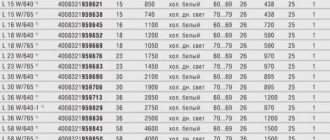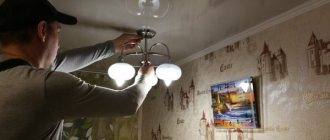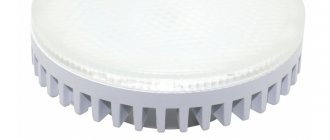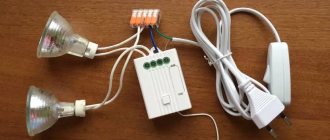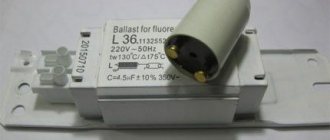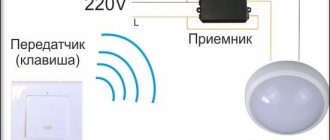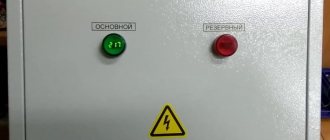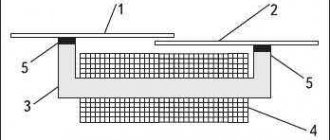Among the huge variety of artificial lighting devices, fluorescent lamps occupy a fairly significant niche. This type of lighting device was first introduced back in 1938, challenging the only monopolists of that time, incandescent light bulbs. Since that time, their design features have undergone significant changes and improvements, due to which fluorescent lamps have become energy-saving. But in order to understand all the pros and cons, and to become more familiar with the features of their use in everyday life and industry, we will study this type of lighting fixtures in detail.
Design and principle of operation
Structurally, fluorescent lamps are a glass bulb, the inner surface of which is coated with a special compound - a phosphor. It consists of calcium halophosphate and other impurities, some versions contain rare earth elements - terbium, europium or cerium, but such combinations are quite expensive.
At the manufacturing stage, all air is pumped out of the flask, and the container is filled with a mixture of inert gases, most often argon, and mercury vapor. Depending on the lamp model, the chemical composition of both inert gases and phosphor will differ. Inside the gas mixture there is a tungsten filament, which is covered with an emitting coating.
Rice. 1. Design and principle of operation of a fluorescent lamp
The principle of operation of such an energy-saving lamp is the following sequence of electrochemical processes:
- A supply voltage is applied to the contacts of a gas-discharge mercury lamp, due to which an electric current begins to flow in the incandescent filament circuit.
- When an electric current flows, thermal energy and emitter particles begin to spread from the surface of the thread, which activate the inert gas and cause the release of ultraviolet radiation.
- The glow of gases has a relatively low percentage of the visible spectrum, since most of it falls on ultraviolet waves. But when the ultraviolet reaches the glass bulb of the gas-discharge lamp, the phosphor is activated and subsequently glows.
The emission spectrum of fluorescent light bulbs can vary over a fairly wide range. The choice of shades of glow in lighting devices is carried out by changing the percentage of magnesium and antimony in the composition of the phosphor.
Also an important point is the temperature indicator, therefore the magnitude of the applied voltage and the flowing electric current must have a constant value for each diameter of the flask. It is strict adherence to the electrical characteristics in relation to its geometric parameters in a fluorescent lamp that allows it to produce the desired color and brightness of the glow.
How to choose the right product
Regardless of whether products are purchased for a home or office, for aquarium plants or flowers, industrial premises or a supermarket, you must approach the purchase seriously. Everyone's selection criteria are different. Which product is best to buy depends on many factors. Experts recommend paying attention to the following parameters:
- Purpose. It is very important to predict weather conditions when installing a lamp outdoors. Humidity indicators and temperature conditions inside the room where energy-saving lamps are to be used are also important.
- Network voltage. Unstable voltage leads to constant flickering and negatively affects people's vision.
- The estimated area of the illuminated room and whether it is possible to install a large light source.
- Device parameters. The dimensions must be chosen so that the lamp fits into the lamp.
- Optimal indicator of power and light flux.
- Manufacturer. It is advisable to give preference to trusted product manufacturers. Defects, of course, are found on shelves, but not in such quantities, and are more the exception than the rule. Which company is better, everyone decides for himself. Here advice is not always appropriate. However, it is worth noting that products from well-known world brands are of high quality and cannot be budget-friendly. Its functionality is advanced, which is why you have to pay extra.
- Build quality. Don't go for inexpensive models. They may be dangerous to use. How much do quality products cost? At least 60 - 100 rubles.
As for the power of the product, supply voltage and color temperature, these data are considered secondary and do not affect the main functions.
Where to buy products? It is advisable to visit a specialized store, take a closer look at the presented assortment, get acquainted with new products, ask the price, and, if necessary, communicate with an experienced sales manager. The main thing is that upon purchase, they issue a warranty card, which will make it possible, if a defect is detected, to replace it with a high-quality design.
There is a second option - order the product online in an online store. In terms of price, this may be more profitable, but there is a chance of getting a low-quality Chinese counterfeit instead of an expensive product from a well-known global brand.
Varieties
The entire variety of fluorescent lamps is characterized by a fairly wide range of parameters. But in this article we will look at the most distinctive of them.
In practice, high- and low-pressure lamps are distinguished according to the gas pressure inside the bulb:
- High pressure - such luminescent devices produce a dense light flux in rich color shades. They are used in fairly powerful models with a rating from 50 to 2000 W, characterized by a service life of 6 thousand to 15 thousand hours.
- Low pressure - characterized by a relatively low density of gas in the container, used for lighting premises in the home or in production.
According to the shape of the bulb of an energy-saving light bulb - the bulb can have a classic pear-shaped shape with a glass spiral inside, an oblong elongated shape, the appearance of a spiral tube twisted around an axis, ring-shaped and other shapes.
Rice. 2. Varieties of flask
Based on the design of the base, fluorescent lamps are distinguished with a standard base E with a numerical designation indicating the diameter of the base of the gas-discharge source. G – pin, in which the number after the letter marking shows the distance between the contacts, and before the number of pairs of contacts. You can also find models with W and F type bases, but they are used quite rarely.
Rice. 3. Types of bases
Based on the color temperature of the glow, fluorescent devices with a hot yellow and cold blue spectrum are distinguished. There are also options for neutral glow colors. Color temperatures are selected in accordance with the tasks: warm for housing, cold for industrial facilities.
Rice. 4. Color temperature
Criterias of choice
When purchasing, you should be guided by the following criteria:
- the size that should suit your light source and its socket;
- power, optimal option 15-25 W;
- expiration date, it is better to choose with the maximum value;
- color temperature must correspond to the interior design or purpose of the room.
- cost, the cheapest option is U-shaped.
In addition to the advantages, there is one significant drawback: the mercury content inside the flask, which belongs to class 1 hazardous substances.
If the lamp breaks, it is necessary to quickly react and collect the mercury particles in a separate container and seal it tightly, then treat this area using a manganese solution and ventilate the room.
Marking
The designation system for fluorescent light bulbs determines their main parameters. However, depending on the country of origin, the designation standards will also differ. For comparison, let’s consider both labeling options using the example of domestic and foreign manufacturers.
Domestic
Domestic marking includes an alphanumeric designation, which includes four positions for letters and one for numbers. For example: LBTSK-60 .
The first letter in the marking L means lamp. The second position is more complex, it can be expressed as one or a pair of letter combinations, it denotes color rendering indices, the following options are possible in it:
- D – daytime spectrum;
- ХБ – cold white glow;
- B – white;
- TB – white warm shades;
- EB – natural spectrum white;
- UV – ultraviolet spectrum;
- G – blue;
- C – blue tint;
- K – red radiation spectrum;
- F - yellow tint
- Z – green.
The third position determines the quality of color rendering, but there are only two options for C - improved quality or CC - especially high quality, which is often used in decorative lighting.
The fourth position indicates the design of the lamp. There are five main positions:
- A – amalgam type;
- B – with quick start;
- K – ring type;
- R – reflector lamps
- U - U shaped.
Foreign
Foreign-made fluorescent lamps have identical marking principles. At the beginning, the power of the product is indicated in watts; it is easily recognized by the Latin letter W.
The type of glow is determined by a digital code with a letter explanation in English:
- 530 is a warm tone of fluorescent lamps, but relatively poor color rendering;
- 640/740 – not quite cold, but close to it with a mediocre level of color rendering;
- 765 – blue tint with a mediocre level of color reproduction;
- 827 – close to an incandescent lamp, but with good color rendition;
- 830 – close to a halogen bulb, with a good level of color rendering;
- 840 – white shade with a good level of color reproduction;
- 865 – daylight spectrum with good color rendering;
- 880 – daylight spectrum with an excellent degree of light transmission;
- 930 – warm tone with excellent color parameters and low light output;
- 940 – cool tone with excellent color rendering and average light output.
- 954/965 – luminescent devices with a continuous spectrum.
Rating of quality fluorescent lamps 2G11
OSRAM DULUX, non-integrated L 80W 830 2G11 10X1
This compact device has a tubular shape and an L-type bulb. The power declared by the manufacturer is 80 W with a luminous flux of 6500 Lm. Emits warm white light. An excellent solution for both residential and office premises. The dimensions are compact and amount to 565x17.5 mm. Weight – 122 g. To avoid mistakes when choosing, you should note the presence of a matte finish. The declared service life is 20 thousand hours, which is considered an excellent indicator.
How much does the device cost? The purchase will cost 538 rubles.
OSRAM DULUX, non-integrated L 80W 830 2G11 10X1
Advantages:
- declared characteristics;
- operational resource;
- compactness;
- suitable for both household and office lamps;
- numerous positive reviews;
- 2 year manufacturer's warranty.
Flaws:
- not identified.
MASTER PL-L 55W 840 2G11 4p PHILIPS
This popular model is in deserved demand among consumers, largely due to its stated characteristics. The compact device is intended for use in conjunction with high-frequency starting or electromagnetic equipment. You can order online from the company’s online store both a product with a removable or plug-in base. Stated dimensions: 541.6x39 mm. Weight – 134 g. According to buyers, the tubular matte bulb and the presence of a four-pin base deserve special attention. Emits cool white light. The declared power is 55 W, with a luminous flux of 4800 lm. An excellent solution for both home and office space. Operating life – 10 thousand hours.
You can purchase it at a price of 511 rubles.
MASTER PL-L 55W 840 2G11 4p PHILIPS
Advantages:
- matte finish;
- compact dimensions;
- Self-installation is allowed;
- four-pin base;
- optimal power;
- one of the best European manufacturers.
Flaws:
- not identified.
DULUX L 36W 840 2G11 OSRAM
This compact model belongs to the budget category. It is characterized by an increased service life of 20 thousand hours and the presence of a natural white glow. Can be used to illuminate bars and restaurants, as well as office and residential premises. The flask has a tubular shape and a matte finish. Luminous flux – 2900 lm. Design power – 36 W. Dimensions: 411x17.5 mm. Weight – 94 g. The product belongs to the category of energy-saving light bulbs. Brand warranty – 2 years.
Average price – 229 rubles.
DULUX L 36W 840 2G11 OSRAM
Advantages:
- operational resource;
- compact dimensions;
- numerous positive reviews;
- copes well with the assigned tasks;
- easy connection;
- clear operating principle.
Flaws:
- not identified.
Specifications
Important technical characteristics for fluorescent lamps are:
- Lamp power - can vary from 10 to 80 W for classic household needs, industrial models can reach 2000 W;
- Rated voltage - in most cases, a voltage of 220V is used;
- Color glow temperature – varies from 2700 to 6500°K;
- Light output - the amount of luminous flux emitted per 1 W of electricity consumed for luminescent devices ranges from 40 to 60 Lm/W, but there are also more efficient models;
- Dimensional parameters – depend on the specific model of the fluorescent lamp;
- Base type – E14 (minion), E27 (standard size), G10 and G13 pin sample and others.
TOP best T3 fluorescent lamps
General Electric GE FLE11TBXT3 827 E27 6Y
This popular model is only suitable for residential and office spaces, as its power is 11 watts. Color temperature – 3300 K. Emits warm white light. The shape of the base is tubular. The inexpensive design has a short service life of 6,000 hours. It is this company that is best to buy products for furnishing public premises. Stated dimensions: 126x20 mm. Weight – 90 g. This figure is sufficient for aquarium plants, but it should be understood that the structure does not have protection from moisture. The manufacturer provides a standard warranty of 14 days from the date of purchase of the product.
Cost – 169 rubles.
General Electric GE FLE11TBXT3 827 E27 6Y
Advantages:
- advanced functionality;
- compactness;
- coating material;
- light weight;
- optimal power;
- positive reviews;
- Do-it-yourself installation is allowed.
Flaws:
- not identified.
DULUX D/E 26W/840 G24q-3 OSRAM
This compact device will be an excellent solution not only for home, but also for office space. The matte finish deserves special attention. Color is cold. The declared power is 26 W, with a luminous flux of 1800 lm. It is characterized by the presence of a high service life - 20 thousand hours. Dimensions: 165x12 mm. Weight – 49 g. The products are in high demand among domestic consumers. The reviews are positive.
Average price – 160 rubles.
DULUX D/E 26W/840 G24q-3 OSRAM
Advantages:
- operational resource;
- manufacturer's warranty;
- matte finish;
- optimal power;
- versatility;
- practicality;
- reliability;
- wide scope of application.
Flaws:
- not identified.
KD-508, 509 Camelion
This popular model belongs to the compact category and is equipped with a pin base. It is noted that there is a soft start system, which has a beneficial effect on the operational life of the device. The model is compatible not only with plastic, but also with fabric shades due to its low heating.
How much does the product cost? The purchase will cost 117 rubles.
KD-508, 509 Camelion
Advantages:
- compactness;
- safety;
- wide scope of application;
- manufacturer's warranty;
- smooth start;
- no flicker.
Flaws:
- not identified.
Features of connecting to the network
In view of the difficulties associated with the ionization of the gas gap, several variants of the switching circuit can be used in fluorescent lamps to simplify the ignition of the discharge. The most popular are the electrical circuits of electromagnetic and electronic ballast, which we will consider further.
Electromagnetic ballast
It is the oldest option used in starting fluorescent lamps with cold cathodes.
Rice. 5. Connection diagram with electromagnetic ballast
As you can see, in this circuit the lamp is connected through an electromagnetic inductor and a starter. At the moment the voltage is applied, the starter, consisting of a bimetallic plate, is a circuit with very low resistance, so the current in it increases significantly, but does not reach the short-circuit value due to the inductor. This process triggers an electrical discharge in the fluorescent lamp, and when heated, the starter electrodes open.
Electronic ballast
This connection method involves the use of a special self-oscillator assembled on a transformer and a transistor unit capable of producing a high frequency voltage, which allows for a flicker-free luminous flux.
Rice. 6. Use of electronic ballast
As you can see, a ready-made electronic ballast unit for powering fluorescent lamps is used in accordance with the connection diagram, which is indicated directly on the product body.
How to install a lighting fixture yourself
Installing the structure is not that difficult. Anyone can do the job. If any difficulties arise, step-by-step instructions posted on the Internet will come to the rescue. The simplest scheme is with a starter and throttle. Consists of two separate devices with personal sockets. There are two capacitors in the circuit, the first is connected in parallel to stabilize the voltage, and the second is located in the starter housing and allows you to increase the duration of the starting pulse. The circuit is called “electromagnetic ballast”.
The functioning of the connection diagram for fluorescent lamps with a starter is as follows:
- Power connection.
- The current passes through the inductor, entering the first tungsten helix.
- By means of the starter, it moves into the second spiral and leaves through the neutral conductor.
- The tungsten filaments begin to heat up, as do the starter contacts.
- The starter has two contacts: fixed and movable bimetallic. In normal condition they are open.
- The passing current heats the bimetallic contacts, which leads to its bending. When bent, it closes with a fixed contact.
- The connected contacts contribute to an increase in current in the circuit (on average 2–3 times). The throttle acts as a limiter.
- A sharp jump occurs, which leads to rapid heating of the electrodes.
- When the starter bimetallic plate cools, the contacts break. The rupture leads to a sharp surge in voltage at the throttle. Due to the high voltage, electrons penetrate the argon medium. Ignition appears and the lamp begins to function in operating mode.
Experts recommend taking product disposal seriously. They cannot be thrown away like regular trash because they contain mercury vapor inside. There are a number of specialized organizations that deal with the disposal of hazardous waste and mercury-containing light bulbs.
Reasons for failure
Quite often, consumers who are faced with the problem of stopping operation or deterioration of the glow parameters of fluorescent lamps ask themselves the question of finding the causes of the malfunction.
The most common reasons for fluorescent lamps to fail are:
- burnout of the filament - characterized by a complete absence of glow;
- violation of the integrity of the contacts also prevents the lamp from lighting up;
- depressurization of the flask with subsequent release of inert gas - characterized by orange flashes;
- burnout of the starter, breakdown of its capacitor - flickering, inability to start for a long time, a black spot near the contacts;
- a break in the inductor winding or a breakdown on the body - does not turn on or gives alternating on/off during the operation of the fluorescent lamp;
- short circuit in the fluorescent lamp socket or its contacts - characterized by blinking, but without subsequent start-up.
TOP best fluorescent lamps G23
9W LH 9-U/842/G23 Camelion
This popular model is designed for arranging rooms with high levels of humidity. Power indicator – 9 W. There is a high light transmission, without visible flicker. The devices are installed both in bathrooms and industrial premises. Allows you to save energy costs.
Average price – 197 rubles.
9W LH 9-U/842/G23 Camelion
Advantages:
- energy saving;
- compactness;
- color rendering;
- no flicker;
- reliability;
- versatility;
- operational resource.
Flaws:
- not identified.
Navigator, NCL-PS-09-840-G23
The power of this small device is 9 W. The optimal solution for arranging a desktop and public spaces. Luminous flux – 580 lm. Dimensions: 165x28 mm. Operating life – 10 thousand hours.
Cost – 182 rubles.
Navigator, NCL-PS-09-840-G23
Advantages:
- light output;
- manufacturer's warranty;
- color rendering;
- no flicker;
- energy saving.
Flaws:
- not identified.
DULUX S 11W/840 G23 OSRAM
This compact light bulb belongs to the fluorescent category. An excellent solution for domestic and administrative premises. It is characterized by an increased service life and allows you to save on electricity. Power – 11 W.
How much does the product cost? The purchase will cost 126 rubles.
DULUX S 11W/840 G23 OSRAM
Advantages:
- color rendering;
- manufacturer's warranty;
- the presence of a matte finish;
- compactness;
- functionality;
- versatility;
- value for money;
- safety.
Flaws:
- not identified.
Advantages and disadvantages
Due to fierce competition in the market, fluorescent lighting devices are usually compared with the operating parameters of lamps of a different operating principle.
The advantages of luminescent devices include:
- Sufficiently high efficiency, in comparison with the same incandescent lamps they produce an order of magnitude greater luminous flux for each watt of electricity consumed;
- It has several color spectrum options, which makes their use justified for various purposes;
- The service life before failure is 10–15 times higher than that of incandescent and halogen lamps;
- Quite a wide variety of designs - compact, large, elongated, etc.
However, fluorescent lamps have many disadvantages:
- Much higher cost;
- The presence of mercury, which, when the flask is destroyed, enters the surrounding space;
- Even surviving used lamps require special disposal, which also requires additional costs;
- Stability of operation largely depends on the temperature and humidity of the environment;
- Fluorescent light bulbs cause increased eye fatigue during prolonged reading or eyestrain;
- Compared to LED lamps, there is no risk of mechanical damage;
- Not amenable to classical brightness control methods.
Rating of the best G5 fluorescent lamps
Navigator 94 109 NTL-T5-21-840-G5 21W T5 4200K G5
The power of this device is 21 W, with a luminous flux of 1575 lm. An excellent solution for furnishing residential premises. The shape is tubular. Stated dimensions: 849x16 mm. Weight – 120 g. Service life is 10 thousand hours.
Average price – 275 rubles.
Navigator 94 109 NTL-T5-21-840-G5 21W T5 4200K G5
Advantages:
- wide scope of application;
- manufacturer's warranty;
- ease of use;
- stability of work;
- doesn't heat up.
Flaws:
- not identified.
T4 G5 20W 6400K FERON EST13 3030
The power of this device is 20 W. An excellent choice for residential premises. A cool white glow is noted. Luminous flux – 1200 lm. Dimensions: 569x12 mm. Weight – 52 g.
Cost – 199 rubles.
T4 G5 20W 6400K FERON EST13 3030
Advantages:
- optimal power;
- manufacturer's warranty;
- compactness;
- ease of use;
- no overheating.
Flaws:
- not identified.
Camelion FT5-8W 33
This popular model is designed for arranging conference rooms, auditoriums and classrooms. The light flux is emitted evenly. The presence of optimal color rendering is noted, due to which the eyes will not get tired during long work or study. There is no cadmium in the composition, which should be taken into account during the selection process.
How much does the device cost? The purchase will cost 168 rubles.
Camelion FT5-8W 33
Advantages:
- universal position;
- operational resource;
- safety;
- wide scope of application;
- manufacturer's warranty.
Flaws:
- not identified.
Application area
The list of areas in which fluorescent lamps can be installed is quite large. Most often you can find them in domestic premises or offices as the main lighting. In stores or shopping centers they are installed as lighting devices for display cases, walls and other interior elements and can easily replace a neon light bulb. They can often be found illuminating corridors and large rooms with elongated tubular fluorescent lamps.
In the industrial sector, they are often used as lamps for floodlighting, which covers a large area. Spotlight fluorescent devices have excellent light transmission, despite the height distance from the illuminated surface.
Rating of high-quality fluorescent lamps 2G7
11W for KD-008C KD-017 Camelion
This product belongs to the compact category. It is used to arrange a workplace or to create natural lighting in residential areas. Suitable for arranging fabric and plastic lampshades due to the low heating temperature. Power – 11 W.
Average price – 216 rubles.
11W for KD-008C KD-017 Camelion
Advantages:
- stable luminous flux;
- operational resource;
- manufacturer's warranty;
- light output;
- practicality;
- functionality;
- value for money;
- energy saving design.
Flaws:
- not identified.
FERON 11W 1U 2G7 4000K, EST9
This compact device is designed for arranging a workplace. The presence of natural white color is noted, with a luminous flux of 770 Lm. Power – 11 W. Service life – 30 thousand hours. Often found in office and retail premises.
How much does the device cost? The purchase will cost 188 rubles.
FERON 11W 1U 2G7 4000K, EST9
Advantages:
- manufacturer's warranty;
- operational resource;
- no flicker;
- does not heat up;
- compactness.
Flaws:
- not identified.
Econ PL 11 W 2G7 4200K 8112g7
Based on the characteristics declared by the manufacturer, this model is intended for arranging bedside tables and workplaces. The flask practically does not heat up, which eliminates the risk of damage to expensive lampshades. The service life is 10 thousand hours.
Cost – 144 rubles.
Econ PL 11 W 2G7 4200K 8112g7
Advantages:
- compactness;
- stability of work;
- manufacturer's warranty;
- value for money;
- practicality;
- safety;
- reliability;
- does not heat up;
- operational resource.
Flaws:
- not identified.
Exotic
In general, the non-standard form of fluorescent lamps dates back to the times of neon advertising. Now that the manufacturer has a lot of opportunities to make a tube of any configuration, shaped lamps have mainly begun to be used for bold design solutions. Such products are not marked with familiar symbols. In order to find out their technical characteristics, you need to look at the product passport.
Such fluorescent lamps fit very well into futuristic interiors. Interestingly, this type of lamp and the light it spreads cannot be achieved using any other type of lighting source.
